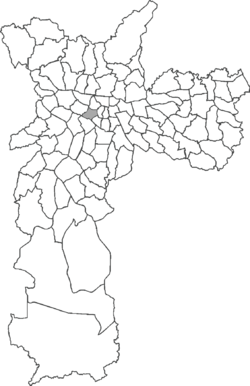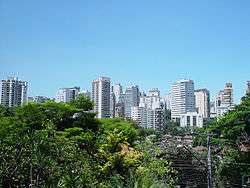Consolação (district of São Paulo)
| Consolação | |
|---|---|
 District of the city of São Paulo | |
 | |
| Country | Brazil |
| State | São Paulo |
| District | Consolação (district of São Paulo) |
| Government | |
| • Type | Subprefecture |
| • Subprefect | Amauri Luiz Pastorello |
| Area | |
| • Total | 3.7 km2 (1.4 sq mi) |
| Population (2010) | |
| • Total | 57,365 |
| • Density | 15,504/km2 (40,160/sq mi) |
| HDI | 0.950 –high |
| Website | Subprefecture of Sé |
| [1] | |
Consolação (Portuguese pronunciation: [kõsolaˈsɐ̃w̃]) is a district in the central part of the city of São Paulo, Brazil. It belongs to the subprefecture of Sé. The district is largely residential, and contains many large apartment buildings and condominiums. It is also known for its prominent cultural institutions. The region has been populated since the 16th century, and is known for its buildings in the style of São Paulo Modern Architecture.[2]
History
Originally, the region of the city which comprises today's Consolação was inhabited by the Jesuits, being called "Sesmaria of Pacaembu." It remained thus until the beginning of the 20th century when it was converted into a neighborhood for the highest class of paulistanos. It was attractive due to its high elevation, wide open streets and an array of woody plants. Also, being far from the Luz train station, and out of the old city center, it was much quieter and cleaner, giving it the name of Higienópolis, "City of Hygiene", which names also an Avenue in the district.
Today, the neighborhood has managed to keep some of the large homes of the past, though little remains of the vast area and giant mansions that once dominated the landscape. A prime example is a building which once was the art-nouveau mansion of the Prado family, near the western end of Angelica Avenue, which today houses the graduate and post-graduate courses of the University of São Paulo's College of Architecture and Urbanism (FAU).
It was in the 1950s that the neighborhood as it is today started to rise from the mansions of the past. Large real estate investments in the area caused the demolition of many of the large mansions and houses by which the neighbourhood was characterized. When this happened, the area became a melting pot of the new, modern architecture and large buildings, and the old elegant architecture of the earlier eras.
In the period between 1970 and 1990, the area was still a place where the wealthy lived to get away from the hustle and bustle of the center of the city, and still contained much of its earlier social segregation.
Consolação today
The region
Today the district is still well known for the large upper class that lives in the area. It managed to keep its social status during the rapid growth of the city, a time when many places such as Campos Elíseos began to shelter a broader range of social classes. Higienópolis contains an enormous amount of large apartment buildings, and very few, if any, houses with permanent residency. Some buildings are multi-purpose, but there are very few large buildings that serve any other purpose other than the residential.
There is currently a large number of Jewish and Jewish descendants living in the region, and there are a number of synagogues and Jewish schools throughout Consolação.

Attractions and events
The area features an array of tourist locations, local cuisine, hotels, art cinemas, many bars and nightclubs, shopping centers (Center3, Shopping Frei Caneca and Pátio Higienópolis) and the Municipal Stadium (Pacaembu Stadium) as well as being near to Paulista Avenue. Pátio Higienópolis, commonly known as Shopping Higienópolis, is located on Higienópolis Avenue, near the corner of Angélica Avenue.
The Rotary Club of São Paulo, the largest Rotary Club in South America, is located in the Higienópolis neighborhood, and contains a well-known private secondary school in the city, Colegio Rio Branco. The Rotary Club regularly hosts fund-raisers and other events inside the school.
Buenos Aires Park is a small region of the neighborhood where one can see a large variety of tropical plants and trees, if only to get away from the noise and pollution of the streets.
Culture and education
Consolação, being in the central area of the São Paulo Metropolis, is home to numerous cultural institutions. These include Fundação Armando Alvares Penteado (FAAP), Mackenzie Presbyterian University, the São Paulo Foundation School of Sociology and Politics, Cultura Inglesa (an English language and culture school), the French Alliance, and the Central University of Maria Antonia. The Roman Catholic Colégio Sion is located on Higienópolis Avenue, right across from the Colégio Rio Branco.[2]
Transportation
The main Street of the district is called Rua da Consolação, which connects São Paulo's downtown to Rebouças, Paulista and Doutor Arnaldo Avenues, and has a bus corridor serving mainly North and Southbound buses across São Paulo. The district is served by 2 subway stations, Consolação (São Paulo Metro) and Paulista (São Paulo Metro) and 2 future stations: Higienópolis-Mackenzie (São Paulo Metro) and Angélica-Pacaembu (São Paulo Metro). Many other stations are in the nearby districts of República (district of São Paulo), Santa Cecília (district of São Paulo), Jardim Paulista (district of São Paulo) and Bela Vista (district of São Paulo).
References
- ↑ "População Recenseada, Taxas de Crescimento Populacional e Densidade Demográfica" (XLS) (in Portuguese). São Paulo, Brazil: Prefeitura Municipal de São Paulo. 2011. Retrieved 2015-02-06.
- 1 2 "Sobre a Consolação" [About Consolação] (in Portuguese). São Paulo, Brazil: Encontra São Paulo. 2015. Retrieved 2015-02-03.
